
Sunday April 18 to Saturday April 24, 2021
– 21 Free Online Events for All Curious Minds –
Thank you to the hundreds of people who participated remotely.
For published CoM presentations please visit the G4G YouTube channel
MONDAY 19th: Jorge Nuno Silva, Tanya and Tim Chartier, James Tanton
TUESDAY 20th: Katie Steckles, Ellie Baker, John Railing
WEDNESDAY 21st Lisa Rougetet, Laura Taalman, Peter Winkler
THURSDAY 22nd: Robert Fathauer, Catriona Agg, Ed Pegg
FRIDAY 23rd: Jeremiah Farrell, Craig Kaplan, Alissa Crans
SATURDAY 24th: Marjorie Wikler Senechal, Colin Wright, Debbie Leifer
Schedule
(click on day of interest to see full information)
Sessions at Noon, 4PM, 8 PM Atlanta, GA time, ET
Noon | “The Magic of Inventing” (~35min.) by Mark Setteducati

For more than 40 years, Mark Setteducati has created games, puzzles and magic tricks that he has sold to toy companies around the world. Where do his ideas come from? Watch and find out how he does it.
Mark is a co-founder and past President of the Gathering for Gardner. He is a Magician and inventor of games, puzzles and magic, with over 50 of his creations marketed by companies worldwide. He is the author of “The Magic Show”, an interactive book that performs magic. In 2014, the Academy of Magical Arts awarded him a Creative Fellowship and lifetime membership to the Magic Castle, Hollywood, California.
4:00 pm | “Math Glass” (~35min.) by Bronna Butler
 Abstract: Can an ancient, non-crystalline, transparent amorphous solid, such as glass, illustrate recent mathematical discoveries, and perhaps create compelling puzzles? Glass can be formed in a variety of ways, for example, it can be a result of volcanic action, lightning striking sand, the impact of a large bomb, or human fabrication. And, although brittle, human-made silicate glass is extremely durable. The colored glass found in 3600 BC beads and 13th century windows is still beautiful today. It is a suitable material to be commingled with beautiful, timeless mathematics.
Abstract: Can an ancient, non-crystalline, transparent amorphous solid, such as glass, illustrate recent mathematical discoveries, and perhaps create compelling puzzles? Glass can be formed in a variety of ways, for example, it can be a result of volcanic action, lightning striking sand, the impact of a large bomb, or human fabrication. And, although brittle, human-made silicate glass is extremely durable. The colored glass found in 3600 BC beads and 13th century windows is still beautiful today. It is a suitable material to be commingled with beautiful, timeless mathematics.
I will present three tabletop sculptures that incorporate clear, or colored, transparent glass to:
1. illustrate a recent mathematical discovery,
2. create a puzzle that utilizes a premise of quantum mechanics, and
3. fabricate two magic cubes out of four uncut square glass panels and vitreous paints. I will review my ongoing efforts to modify the glass magic cubes to create a puzzle, currently still “in beta”.
Bronna Butler (https://www.bronnabutler.com, @bronnabutler on Twitter) is a professional artist who creates glass, mirror, and metal sculptures, as well as two-dimensional artwork, with a focus on recreational mathematics, mathematics outreach initiatives, physics, and science. She frequently incorporates puzzles, enigmas, and optical illusions in her work. Bronna has a B.A. in Art and an M.S. in Accounting from the University of Missouri. After being a financial executive for 22 years for creative entrepreneurial firms in design, publishing, and telecommunications, she founded B.A. Baroque Arts, LLC in 1997, (facebook.com/BABaroqueArts). Since then, she has completed numerous commissioned pieces, including a twenty-foot-tall stainless-steel monument, 900 square feet of stained-glass windows, and over 155 oil and pastel paintings.
8:00 pm | “Playing the Game of Life” (~40min.) by Mark Mitton

Mark performs and produces events all over the world. He has performed magic for business leaders, star athletes, Nobel prize-winning scientists, royalty and rock stars, economic migrants on the island of Lesbos and hospitalized children around New York City. Inspired by Martin Gardner, Mark believes that the craft of magic can be used to consider surprising possibilities in many aspects of life, including mathematics, education, perception and memory.
Noon | “Tratado da Pratica D’Arismetyca (1519) by Gaspar Nycolas” (~35min.) by Jorge Nuno Silva
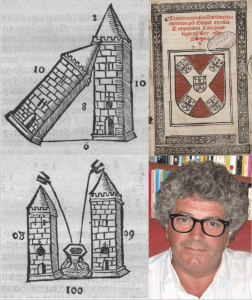 This Tratado was the first mathematical text published in Portuguese. By then, the Portuguese had already been travelling to the East and trading was important, being also present at the European markets. Therefore, it was vital to educate in commercial arithmetic large numbers of people. This Tratado helps to fulfil that need. It just happens that it contains a substantial section on recreational problems. We will show some of them, as they deserve attention on their own right.
This Tratado was the first mathematical text published in Portuguese. By then, the Portuguese had already been travelling to the East and trading was important, being also present at the European markets. Therefore, it was vital to educate in commercial arithmetic large numbers of people. This Tratado helps to fulfil that need. It just happens that it contains a substantial section on recreational problems. We will show some of them, as they deserve attention on their own right.
Jorge Nuno Silva, PhD Mathematics UC Berkeley 1994. Professor at the University of Lisbon. President of Ludus.
4:00 pm | “Mime-matics” (~30min.) by Tanya and Tim Chartier
 In Mime-matics, Tanya and Tim Chartier explore mathematical ideas through the art of mime. Whether creating an illusion of an invisible wall, wearing a mask covered with geometric shapes or pulling on an invisible rope, Tim and Tanya Chartier delve into mathematical concepts such as estimation, tiling, and infinity. Through Mime-matics, audiences encounter math through the entertaining style of a performing artist who have performed at local, national and international settings.
In Mime-matics, Tanya and Tim Chartier explore mathematical ideas through the art of mime. Whether creating an illusion of an invisible wall, wearing a mask covered with geometric shapes or pulling on an invisible rope, Tim and Tanya Chartier delve into mathematical concepts such as estimation, tiling, and infinity. Through Mime-matics, audiences encounter math through the entertaining style of a performing artist who have performed at local, national and international settings.
The Chartiers have trained in master classes with world-renowned mime artist Marcel Marceau and at Le Centre du Silence mime school. Come enjoy a show seen in Japan, the Netherlands, South Korea, Panama and throughout the United States.
8:00 pm | “Pile Splitting” (~30min.) by James Tanton
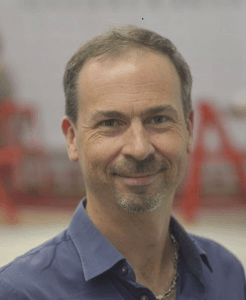 Take a pile of nine pebbles or nine coins or nine cucumbers (but not zucchini) and split them into two piles. Then split each of those piles into two piles. And keep doing this until you have nine piles each with one object.
Take a pile of nine pebbles or nine coins or nine cucumbers (but not zucchini) and split them into two piles. Then split each of those piles into two piles. And keep doing this until you have nine piles each with one object.
What could be mathematically astounding about such a process? A scary, tremendous amount of astonishing mathematical stuff! Let’s explore that mathematics together.
James Tanton is an author, an educator, a consultant, and ambassador for the Mathematical Association of America in Washington D.C.and founder of the Global Math Project, an initiative to transform the entire world’s perception of what mathematics can, and should, be. This program has now reached over 6 million students and teachers across the planet.
Noon | “Puzzles with Bridges” (~30min.) by Katie Steckles
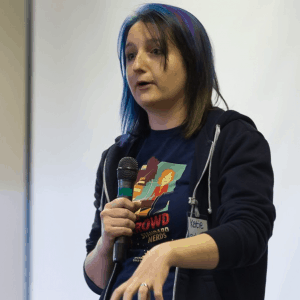 Katie presents a pair of probability puzzles, regarding bridges across a river. Maybe there’s more to these two puzzles than you might first imagine…
Katie presents a pair of probability puzzles, regarding bridges across a river. Maybe there’s more to these two puzzles than you might first imagine…
Katie Steckles is a mathematician based in Manchester, who gives talks and workshops and writes about mathematics. She finished her PhD in 2011, and since then has talked about maths at universities, schools events, festivals, on BBC radio and TV, in books and on the internet.
4:00 pm | “Crafts, Math, and the Joy of Turning Things Inside Out” (~45min.) by Ellie Baker
 Crafting projects, and my design aspirations for them, have led me to a series of engaging puzzles. Although this is a story about learning some fascinating mathematics by solving crafting puzzles, my particular theme for this talk is about turning things inside out – or what I call inversions. A series of projects, over multiple years, led to the design of a very unusual reversible infinity-style scarf with the entertaining feature that it can be turned inside out to expose not just two different surfaces…but three! I’ll start with a demonstration of it, and then describe a series of sewing and crafting puzzles, and their solutions, that led me to understand how to make it. No particular math background is required to follow along.
Crafting projects, and my design aspirations for them, have led me to a series of engaging puzzles. Although this is a story about learning some fascinating mathematics by solving crafting puzzles, my particular theme for this talk is about turning things inside out – or what I call inversions. A series of projects, over multiple years, led to the design of a very unusual reversible infinity-style scarf with the entertaining feature that it can be turned inside out to expose not just two different surfaces…but three! I’ll start with a demonstration of it, and then describe a series of sewing and crafting puzzles, and their solutions, that led me to understand how to make it. No particular math background is required to follow along.
Dr. Ellie Baker has a B.F.A. in Sculpture from the Rhode Island School of Design and a PhD. in Computer Science from Harvard University. Together with mathematician Dr. Susan Goldstine, she is co-author of the 2014 book Crafting Conundrums: Puzzles and Patterns for the Bead Crochet Artist, which collects their extensive research on mathematical bead crochet. She has worked as a high school Fine Arts Teacher, a Software Engineer, and a Computer Science Researcher, including stints at computing pioneers Bolt, Beranek, and Newman, and Thinking Machines Corporation. Over the last decade she has produced many artworks exhibited in juried shows of mathematical art, such as the national Joint Mathematics Meetings, Bridges (an international mathematics and art interdisciplinary conference), and MoSAIC (Mathematics of Science, Art, Industry, and Culture).
8:00 pm | “The Magic of Movable Books: A history of pop-up books and paper engineering” (~35min.) by John Railing
 Movable books began with science and math treatises in the 1500s – had its Golden Age in the late 19th C. – and its renaissance beginning in the 1960s, mainly due to a handful of pioneers in mass-producing hand-assembled books inexpensively. John has amassed a collection of over 6,000 movable books. He will share some of the highlights of his collection with a focus on the creative genius of the leading paper engineers and how they work their unique magic with books and the specialized printed advertising promotions.
Movable books began with science and math treatises in the 1500s – had its Golden Age in the late 19th C. – and its renaissance beginning in the 1960s, mainly due to a handful of pioneers in mass-producing hand-assembled books inexpensively. John has amassed a collection of over 6,000 movable books. He will share some of the highlights of his collection with a focus on the creative genius of the leading paper engineers and how they work their unique magic with books and the specialized printed advertising promotions.
John Railing is widely considered one of the top close-up magicians in the U.S. John performs regularly for celebrities, entertainers, and leading corporate executives, and has performed for U.S. presidents, foreign dignitaries, and heads of state from around the world. John co-wrote and produced a series of top-selling magic sets called The Ultimate Magic Club, each with its own DVD, for Scholastic Books. He recently released 25 Awesome Card Tricks. He has consulted on film and stage productions, created illusions for trade fairs and corporate shows, and produced myriad products for the magic and toy industries. He has produced some of the largest advertising projects involving pop-ups and optical illusions. With his many interests and a varied background, John is also a bibliophile with one of the largest collections of movable (pop-up) books in the world.
Noon | “The role of mathematical recreations in the 17th and 19th centuries: a (hi)story illustrated through Nim Game and Dots-and-Boxes” (~45min.) by Lisa Rougetet
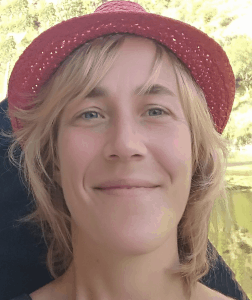 The aim of this talk is to retrace the history of mathematical recreations since the first books entirely dedicated to them at the beginning of the 17th century and at the end of the 19th century, especially in Europe. I will explain what mathematical recreations were exactly when they first appeared and what was their aim. With two examples with Nim Game and Dots-and-Boxes, we will see that the role of recreational mathematics and the interest they rose among mathematicians were quite different according to the times.
The aim of this talk is to retrace the history of mathematical recreations since the first books entirely dedicated to them at the beginning of the 17th century and at the end of the 19th century, especially in Europe. I will explain what mathematical recreations were exactly when they first appeared and what was their aim. With two examples with Nim Game and Dots-and-Boxes, we will see that the role of recreational mathematics and the interest they rose among mathematicians were quite different according to the times.
Lisa is a lecturer at the Université de Bretagne Occidentale (Brittany, France), where she teaches history of mathematics. She defended her PhD in 2014 on the history of combinatorial game theory. Her research interests include the history of the first Nim and chess playing machines and the history of combinatorial games programming in general and recreational mathematics. She is also concerned with connections between board games, computer algorithms and history, and their application in mathematics education. Her article “A Prehistory of Nim” was selected for the collection Best Writing on Mathematics 2015, Princeton University Press.
4:00 pm | “3D printed Hinged Dissections and Foldable Polyhedra” (~10min.) by Laura Taalman
 We’ll talk briefly about 3D printing foldable and hinged models for polygonal and polyhedral dissections, and a new idea for “volume nets” for which I am seeking feedback. Included will be access to 3D design files that people can use to create their own models. Q&A at the end can extend to technical questions about 3D printing enclosed hinges and flexible, foldable materials, depending on interest.
We’ll talk briefly about 3D printing foldable and hinged models for polygonal and polyhedral dissections, and a new idea for “volume nets” for which I am seeking feedback. Included will be access to 3D design files that people can use to create their own models. Q&A at the end can extend to technical questions about 3D printing enclosed hinges and flexible, foldable materials, depending on interest.
Laura Taalman is a Professor of Mathematics at James Madison University whose published research has included algebraic geometry, knot theory, and games. Also known as “mathgrrl”, Dr. Taalman is a computational designer who leverages a diverse toolbox of 3D design software and technical materials to create elegant and aesthetic realizations of idealized mathematical objects. She is a Project NExT Fellow, a recipient of the Alder Award, Trevor Evans Award, and SCHEV Outstanding Faculty Award, and has been featured on Thingiverse, Adafruit, and Science Friday.
8:00 pm | “Drawing from Urns” (~30min.) by Peter Winkler
 Many problems in probability and statistics can be modeled as follows: before you are two urns containing some colored balls. You know the contents of urn A, and the (different) contents of urn B, but you don’t know which urn is A and which is B.
Many problems in probability and statistics can be modeled as follows: before you are two urns containing some colored balls. You know the contents of urn A, and the (different) contents of urn B, but you don’t know which urn is A and which is B.
You get two chances to draw a ball at random, in order to help you guess which urn is which.
Should you draw two balls from one urn, or one from each?
If you are forced to draw two balls from one urn, should you put the first ball back before drawing the second, or leave it out?
Peter Winkler is the William Morrill Professor of Mathematics and Computer Science at Dartmouth College. He is the author of about 160 research papers and holds a dozen patents in marine navigation, cryptography, holography, gaming, optical networking, and distributed computing. His research is primarily in combinatorics, probability, and the theory of computing, with forays into statistical physics. He is a winner of the Mathematical Association of America’s Lester R. Ford and David P. Robbins prizes.
For the academic year 2019-2020, Dr. Winkler served as Distinguished Visiting Professor for the Public Dissemination of Mathematics at the National Museum of Mathematics.
Dr. Winkler has written three collections of mathematical puzzles, a book on cryptology in the game of bridge, and a portfolio of compositions for ragtime piano.
His latest book is “Mathematical Puzzles,” CRC Press, 2021.
Noon | “Tessellations: Mathematics, Art, and Recreation” (~30min.) by Robert Fathauer
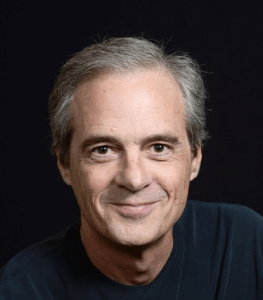 A tessellation, also known as a tiling, is a collection of shapes (tiles) that fit together without gaps or overlaps. Tessellations are a topic of mathematics research as well as having many practical applications, the most obvious being the tiling of floors and other surfaces. There are numerous examples of tessellations in nature, and they’ve been used in cultures around the world for decorative purposes. In addition, tessellations often appear in games and puzzles, and they lend themselves to a variety of recreational mathematics explorations. This talk will provide a brief introduction to the topic, focusing on some of the author’s favorite recreational mathematics examples
A tessellation, also known as a tiling, is a collection of shapes (tiles) that fit together without gaps or overlaps. Tessellations are a topic of mathematics research as well as having many practical applications, the most obvious being the tiling of floors and other surfaces. There are numerous examples of tessellations in nature, and they’ve been used in cultures around the world for decorative purposes. In addition, tessellations often appear in games and puzzles, and they lend themselves to a variety of recreational mathematics explorations. This talk will provide a brief introduction to the topic, focusing on some of the author’s favorite recreational mathematics examples
Robert Fathauer has had a life-long interest in art, but studied Physics and Mathematics in college, going on to earn a Ph.D. from Cornell University in Electrical Engineering. For several years he was a researcher at the Jet Propulsion Laboratory in Pasadena, California. Long a fan of M.C. Escher, he began designing his own tessellations with lifelike motifs in the late 1980’s. In 1993, he founded a business, Tessellations, to produce puzzles based on his designs. Over time, Tessellations has grown to include mathematics manipulatives, polyhedral dice, and books. Dr. Fathauer’s mathematical art has always been coupled with recreational math explorations. These include Escheresque tessellations, fractal tilings, and iterated knots. After many years of creating two-dimensional art, he has recently been building ceramic sculptures inspired by both mathematics and biological forms. Another interest of his is photographing mathematics in natural and synthetic objects, particularly tessellations. In addition to creating mathematical art, he’s strongly committed to promoting it through group exhibitions at both the Bridges Conference and the Joint Mathematics Meetings. His book entitled “Tessellations: Mathematics, Art, and Recreation” was recently published by CRC Press.
4:00 pm | “Generating Geometric Puzzles” (~30min.) by Catriona Agg
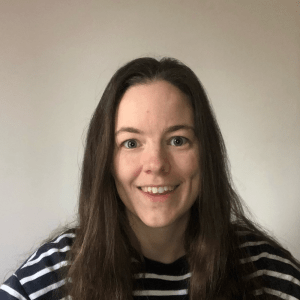 i enjoy creating simple geometry puzzles that delight the viewer with an apparently complex problem to solve using far too little information. There are a number of beautiful geometric facts, some well-known and some more obscure, that can be used to generate such puzzles. For example, I love the fact that you can find the area of an annulus from just one measurement, and I’ve made a number of puzzles based on that fact. I will show three examples of “classic” puzzles that can be dressed up in new ways, so that people can enjoy them again and again.
i enjoy creating simple geometry puzzles that delight the viewer with an apparently complex problem to solve using far too little information. There are a number of beautiful geometric facts, some well-known and some more obscure, that can be used to generate such puzzles. For example, I love the fact that you can find the area of an annulus from just one measurement, and I’ve made a number of puzzles based on that fact. I will show three examples of “classic” puzzles that can be dressed up in new ways, so that people can enjoy them again and again.
I teach maths to 11-18 year olds at a secondary school in Essex, England. When I’m not teaching, I spend most of my time drawing geometry puzzles, colouring them in with felt tip, and posting them on Twitter (the perfect lockdown hobby!)
8:00 pm | “New Substitution Tilings” (~40min.) by Ed Pegg
 A previously unknown substitution tiling can be directly built from powers 0 to 4 of a complex root of x^3 = x^2+1, the supergolden ratio. This talk will discuss new and old tiling systems and the algebraic roots behind them.
A previously unknown substitution tiling can be directly built from powers 0 to 4 of a complex root of x^3 = x^2+1, the supergolden ratio. This talk will discuss new and old tiling systems and the algebraic roots behind them.
Ed Pegg Jr is a long time recreational mathematician who worked on the Numb3rs TV show, Mathworld, Cut-the-Knot, mathpuzzle.com and the Wolfram Demonstrations Project.
Noon | “Puzzles and Games for the Blind” (~35min.) by Jeremiah Farrell

My presentation will describe several items I have had success with for blind students all over the United States. I discuss ideas which teachers of the blind can implement, because of the use of tactile props, different shapes replacing traditional colored pieces, and so on. Many classical physical puzzles can thus be adapted to work with blind people in ways that standard versions would not.
I have taught mathematics at Butler University since 1966. I was the fourth and last editor of Word Ways: The Journal of Recreational Linguistics and have attended all Gatherings for Gardner in Atlanta. Also I have exchanged original puzzles at many International Puzzle Parties all over the world.
A list of over 300 articles is included at https://works.bepress.com/jeremiah-farrell/ at Butler University. Perhaps the most famous is my November, 1996 New York Times crossword Puzzle that predicted the winner of the Presidential race that year. It was one of editor Will Shortz’ favorite puzzles.
4:00 pm | “Parquet Deformations: the tiles, they are a-changin’” (~30min.) by Craig Kaplan
 A Parquet Deformation is a tessellation that evolves gradually in space, a kind of animation expressed in a single drawing. William Huff developed Parquet Deformations and used them as an exercise for architecture and design students for decades. For a computer scientist, they also represent an ideal opportunity for procedural drawing in software: the artist specifies the “keyframes” for the parquet deformation, and the computer interpolates the intermediate tile shapes to complete the design. I will introduce Parquet Deformations, show how to draw them using the theory of isohedral tilings, and present my own experiments in creating new designs.
A Parquet Deformation is a tessellation that evolves gradually in space, a kind of animation expressed in a single drawing. William Huff developed Parquet Deformations and used them as an exercise for architecture and design students for decades. For a computer scientist, they also represent an ideal opportunity for procedural drawing in software: the artist specifies the “keyframes” for the parquet deformation, and the computer interpolates the intermediate tile shapes to complete the design. I will introduce Parquet Deformations, show how to draw them using the theory of isohedral tilings, and present my own experiments in creating new designs.
Craig S. Kaplan is an Associate Professor in the School of Computer Science at the University of Waterloo. He studies the application of computer graphics and mathematics to problems in art, architecture and design, and is an expert on topics such as Islamic geometric patterns and computational applications of tiling theory. He also enjoys experimenting with computer-aided art and design using modern technology like 3D printing.
8:00 pm | “Twisty Mazes” (~30min.) by Alissa S. Crans
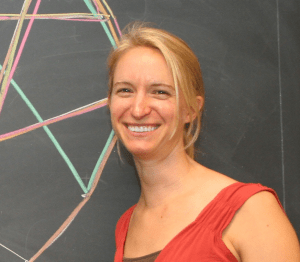 Looking for a new direction to take your affinity for twisty puzzles? The KO Labyrinth seeks to marry the Rubik’s cube with a three-dimensional rolling marble maze as a colorful spherical puzzle with 26 chambers. Holes in the faces of the chambers allow a small ball to pass when aligned correctly.
Looking for a new direction to take your affinity for twisty puzzles? The KO Labyrinth seeks to marry the Rubik’s cube with a three-dimensional rolling marble maze as a colorful spherical puzzle with 26 chambers. Holes in the faces of the chambers allow a small ball to pass when aligned correctly.
We will discover that the shortest path through the maze visits only ten chambers, whereas a random walk visits, on average, about 340 chambers before reaching the end. We’ll explore questions related to connectivity of the puzzle and ask whether it remains solvable if certain chambers are declared off-limits. Finally, we will consider possible metrics on the difficulty of this type of maze and investigate bounds on these metrics.
Alissa’s enthusiastic ability to share and communicate mathematics has earned her national recognition by the Mathematical Association of America with the Hasse Prize for expository writing and the Alder Award for distinguished teaching. She is known for her work in the field of higher-dimensional algebra, supported by the NSA and the Simons Foundation, and her active mentoring and supporting of women, underrepresented students, and junior faculty. Alissa is dedicated to helping students, and the general public, increase their appreciation and enthusiasm for her discipline. She generates excitement about math in settings that range from the National Math Festival in Washington DC and the National Museum of Mathematics in New York City, to “Nerd Nite Los Angeles” and public school classrooms. When not enticing students with the beauty of mathematics at Loyola Marymount University, you can find her rehearsing with the Santa Monica College Wind Ensemble or on her quest to find the spiciest salsa in Los Angeles.
Noon | “Unwrapping a Gem“ (~25min.) by Marjorie Wikler Senechal
 If the celebrated Scottish zoologist D’Arcy W. Thompson (1860 – 1948) could have met the near-legendary German astronomer Johannes Kepler (1571 – 1630), what would they talk about? Snowflakes, maybe? It is true that both men wrote about their hexagonal shapes. But they both wrote about Archimedean polyhedra too, I think Thompson would show Kepler the insightful cardboard models he made for the International Congress of Mathematicians in Toronto in 1924. What was his insight, and what can we see?
If the celebrated Scottish zoologist D’Arcy W. Thompson (1860 – 1948) could have met the near-legendary German astronomer Johannes Kepler (1571 – 1630), what would they talk about? Snowflakes, maybe? It is true that both men wrote about their hexagonal shapes. But they both wrote about Archimedean polyhedra too, I think Thompson would show Kepler the insightful cardboard models he made for the International Congress of Mathematicians in Toronto in 1924. What was his insight, and what can we see?
Marjorie Senechal is a mathematician and historian of science who spent her career at Smith College. She is an expert on mathematical crystallography (including 2D tessellations and 3D quasicrystals), as well as silk, and has written and/or edited a dozen books. She recently concluded fifteen years as editor-in-chief of The Mathematical Intelligencer.
4:00 pm | “Colours Can Compute” (~45min.) by Colin Wright
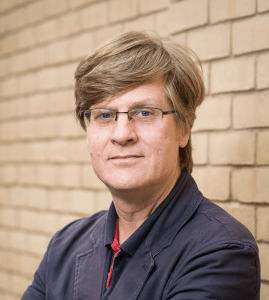 Colouring maps and networks seems like child’s play, but in truth it turns out to be much more interesting, and to have wide-reaching consequences. In this talk we’ll play with some colourings, and see why it’s an important problem and the subject of current research.
Colouring maps and networks seems like child’s play, but in truth it turns out to be much more interesting, and to have wide-reaching consequences. In this talk we’ll play with some colourings, and see why it’s an important problem and the subject of current research.
This talk has a practical component. Ahead of time, you can download the worksheet here OR the individual components Network-A and Network-C.
Colin spends his time exploring how maths keeps popping up in unexpected places. He started giving talks over 35 years ago, and for the past two decades has been giving 150 to 200 presentations and workshops a year throughout the UK and internationally. He is founder and director of Solipsys Ltd, a company providing outreach and enhancement in STEM subjects, focusing on mathematics. Colin has appeared on The One Show, How 2, Blue Peter, Tomorrow’s World, Come Dancing, and BBC News. In what’s laughingly called his “free time” he juggles, and goes ballroom dancing. Occasionally he plays piano (badly),
Bridge (worse), and Go (worst of all). When necessary he programs in C, Python, fexl, and bash.
8:00 pm | “MathMagical Mysteries” (~45min.) by Debbie Leifer
 Combining principles of card and math magic, this presentation will amaze and entertain you. Following an interactive performance, Debbie will teach an easy-to-perform card trick.
Combining principles of card and math magic, this presentation will amaze and entertain you. Following an interactive performance, Debbie will teach an easy-to-perform card trick.

Hi, can we expect all of this week’s presentations to appear on the youtube channel at some point? If there are ones that won’t can you indicate that so we can be sure to catch them?
More generally, it would be useful to have links from the event announcement pages to the videos themselves both those in the past and the future. Previous announcements seem to still include a zoom link which I would find quite marvelous if the application now includes the ability to go back in time.
Thanks!
Paul
Thanks for your comments!
The practice and policy is to get the videos up 2-3 months later (after post production) at https://www.youtube.com/c/G4GCelebration. There were problems with 2 of the video feeds from October, so we were unable to post those. The plan is to get all 21 of this week’s session videos up on YouTube by mid summer, starting in June. It’s a big job and it costs money.
You are right, it would be nice to link to individual videos on YT from their listings on our site. We will try to get to it soon.
We are a volunteer organization with limited resources. This new Celebration of Mind Zoom and video initiative (with 52 live sessions per year, concentrated in key weeks in October and April) is a way to keep the G4G community connected, as well as hopefully also attract new people who value creativity.
We welcome donations at https://www.gathering4gardner.org/donate, and of course we’d love more volunteers too.
The rest of the week’s session should be every bit as awesome as yesterday’s were, please try catch as many as you can!
If it’s web stuff I can help with that.
We’re starting post production on a few of this week’s CoM videos (it takes time to do all 21) and within 2 weeks we hope to have these on YouTube:
Mark Setteducati
Ellie Baker
Pete Winkler
Catriona Agg
(also Kate Jones’ presentation from March)
Check the 2021 CoM playlist https://www.youtube.com/playlist?list=PL5_D5QQxvWKVtX4Vklvhsf5KTYZBLDSwO and you will find videos appearing gradually.
The 2020 CoM videos are here https://www.youtube.com/playlist?list=PL5_D5QQxvWKWNk0EsLClgMN2cIsKTbhDw
These talks were delightful. Seeing presenters in their home environment was great! For example Robert Fathauer was able to show us ceramic items that would have been difficult to transport to a physical Gathering or Celebration. John Railing could turn around and instantly pull a book off his shelf that illustrated a popup point during his Q&A. What a treat! Same with Mark Setteducati and his game sets. Jorge Nuno Silva and Lisa Rougetet gave mind blowing historical accounts. I could go on! I got to hear Catriona’s British voice, which I had not imagined on Twitter .. now I can. Ed Pegg and James Tanton are from another planet, it seems, going places I where no mind has gone before, at least my mind. Wow! This was really a successful event. Kudos to all who presented and to the Organizers. (It’s strange that due to the pandemic, the presenters were their own A/V technicians. I’m impressed — I haven’t share my screen in Zoom yet!)
Thanks to all the presenters, I’ve seen a few of the talks live and plan on watching the rest afterward.
It was at once, informative, entertaining and at times changing how I thought of some thing.
Thanks to all the organisers, none of this takes place in a vacuum.
Great talk by Pete Winkler, a fascinating, deep theorem in elementary probability.
Thanks for a spectacular week of intellectual treats, a true Celebration of Mind with art and mathematics. Superb in every way, meeting outstanding individuals and sharing their passion of designing, creating, solving, research and discoveries. Well worth rearranging our personal programs to be there for every inspiring session, communicating with wonderful people all around the world. My appreciation to you and your team for making it happen. I’d like to think that somewhere in a parallel universe Martin Gardner is smiling. Applause, applause to all the presenters and organizers, and thanks that the Celebrations will continue monthly.
What a week this has been! We began the week with Mark Setteducati describing the process by which he creates magic, and ended the week with magic instruction and entertainment by magician Debbie Leifer. And there were so many other marvelous presentations in between!
“I’m in awe at how wonderful this talk was!”, is the comment I posted immediately after Marjorie Senechal’s presentation. Her “Unwrapping a Gem” spanned centuries and tied together astronomer Johannes Kepler, Scottish zoologist D’Arcy W. Thompson, mathematician Dorothy Wrinch, Archimedean polyhedra, and the structure of proteins. Wow!
And there were those little delightful moments, some off the beat. I laughed aloud when Debbie Leifer asked a nine-year-old participant where he was from, and his immediate reply was “Cyberspace.”
I want to express by deep gratitude to the g4g board, the volunteers, and (of course) the presenters for such a wonderful CoM experience.
Thank you for organizing this. Being based in Europe I’ve only managed to see two out of three talks each day but I’ll make sure I see (most of?) the others when they appear on YouTube. I enjoyed the range of topics and I’ve done what I can to encourage various of my contacts to tune in to some of these. The Q&A after many talks was especially useful and interesting. I look forward to future monthly and semi-annual CoMs in a similar style.
A huge thank you to the organizers and hosts for this series of talks. I watched many of the talks live, but couldn’t catch them all — so I’m grateful I’ll be able to circle back and watch the ones I missed later on YouTube. As a presenter myself, I was initially worried about how it would go speaking to an audience I couldn’t see. And of course at this point in the pandemic we are all kind of burnt out on the virtual venue. But the experience was much richer and more rewarding than I expected. There was a palpable sense of community that built throughout the week. From mathematical artists, to puzzlers, to fascinating math history, to longstanding unsolved problems in mathematics, these presentations will continue to percolate in my mind and provide inspiration going forward. Much of what I was sad to have missed due to pandemic cancellations of conferences and other events was achieved here anyway — and in a manner that will persist and continue to benefit all of us. Truly a celebration of mind! Thank you again!
G4G14 has been postponed twice. Hopefully it will happen in the fall. In the mean time I have unfortunately failed to participate in the virtual CoM last year. Not this time! I was aware and I have participated. I have skipped only two presentations. The time of the last presentation each day was not optimal for me as it started at 2 AM in the morning.
Of course I can still watch each presentation at a convenient time, but nothing beats being there when it happens.
Seeing the comments come in the chat, but also observing the silence in the chat when every attendee is completely focused on the presentation. I will not say that each presentation was equallly good and /or interesting but that is pure personal. I would not want to have missed any of them. Thanks go to all presenters and organisers!
The setting: a webinar in zoom is a bit surreal. I understand this from a technical standpoint, but it is strange not to know how many are attending and/or who is attending. Also inconvenient is that you cannot save the chat (copy-past is possible, but a bit primative). Looking forward to the next event.
A big thank you to the presenters, moderators, organizers and participants for a great April 2021 G4G Celebration of Mind! The variety of topics, expertise, and creativity was amazing. The Zoom format facilitated a gathering of presenters and participants from all over the world. It was a most remarkable gathering of exceptional individuals. I am looking forward to seeing the YouTube recordings of the presentations that I was not able to attend.
Many thanks for this exceptionally mind-enriching week! <3 <3 <3